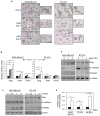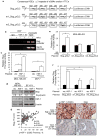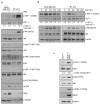Akt phosphorylates and activates HSF-1 independent of heat shock, leading to Slug overexpression and epithelial-mesenchymal transition (EMT) of HER2-overexpressing breast cancer cells
- PMID: 24469056
- PMCID: PMC4112182
- DOI: 10.1038/onc.2013.582
Akt phosphorylates and activates HSF-1 independent of heat shock, leading to Slug overexpression and epithelial-mesenchymal transition (EMT) of HER2-overexpressing breast cancer cells
Abstract
Epithelial-mesenchymal transition (EMT) is an essential step for tumor progression, although the mechanisms driving EMT are still not fully understood. In an effort to investigate these mechanisms, we observed that heregulin (HRG)-mediated activation of HER2, or HER2 overexpression, resulted in EMT, which is accompanied with increased expression of a known EMT regulator Slug, but not TWIST or Snail. We then investigated how HER2 induced Slug expression and found, for the first time, that there are four consensus HSF sequence-binding elements (HSEs), the binding sites for heat shock factor-1 (HSF-1), located in the Slug promoter. HSF-1 bound to and transactivated the Slug promoter independent of heat shock, leading to Slug expression in breast cancer cells. Mutation of the putative HSEs ablated Slug transcriptional activation induced by HRG or HSF-1 overexpression. Knockdown of HSF-1 expression by siRNA reduced Slug expression and HRG-induced EMT. The positive association between HSF-1 and Slug was confirmed by immunohistochemical staining of a cohort of 100 invasive breast carcinoma specimens. While investigating how HER2 activated HSF-1 independent of heat shock, we observed that HER2 activation resulted in concurrent phosphorylation of Akt and HSF-1. We then observed, also for the first time, that Akt directly interacted with HSF-1 and phosphorylated HSF-1 at S326. Inhibition of Akt using siRNA, dominant-negative Akt mutant, or small molecule inhibitors prevented HRG-induced HSF-1 activation and Slug expression. Conversely, constitutively active Akt induced HSF-1 phosphorylation and Slug expression. HSF-1 knockdown reduced the ability of Akt to induce Slug expression, indicating an essential role that HSF-1 plays in Akt-induced Slug upregulation. Altogether, our study uncovered the existence of a novel Akt-HSF-1 signaling axis that leads to Slug upregulation and EMT, and potentially contributes to progression of HER2-positive breast cancer.
Conflict of interest statement
The authors declare no conflicts of interest.
Figures







References
-
- Thiery JP, Acloque H, Huang RY, Nieto MA. Epithelial-mesenchymal transitions in development and disease. Cell. 2009;139:871–890. - PubMed
-
- De Craene B, Berx G. Regulatory networks defining EMT during cancer initiation and progression. Nat Rev Cancer. 2013;13:97–110. - PubMed
-
- Trimboli AJ, Fukino K, de Bruin A, Wei G, Shen L, Tanner SM, et al. Direct evidence for epithelial-mesenchymal transitions in breast cancer. Cancer Res. 2008;68:937–945. - PubMed
-
- Hajra KM, Chen DY, Fearon ER. The SLUG zinc-finger protein represses E-cadherin in breast cancer. Cancer Res. 2002;62:1613–1618. - PubMed
Publication types
MeSH terms
Substances
Grants and funding
LinkOut - more resources
Full Text Sources
Other Literature Sources
Medical
Molecular Biology Databases
Research Materials
Miscellaneous

